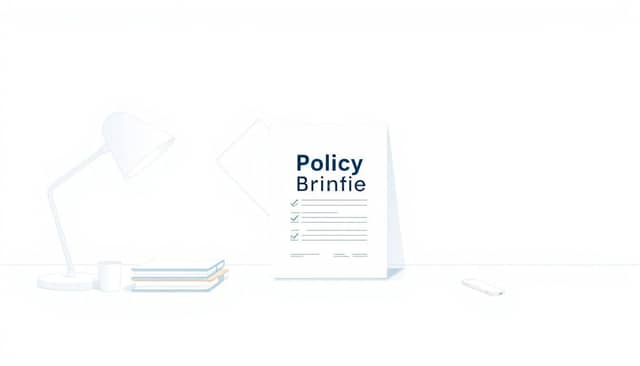Table of Contents
Writing a policy paper can feel like navigating a maze, right? You might be wondering where to start or how to make your points clear.
Don’t worry, I’ve got your back! By the end of this, you’ll have a straightforward guide to crafting an effective policy paper.
We’ll cover everything from understanding what a policy paper is to nailing a clear and concise policy brief.
Key Takeaways
- A policy paper is a research-based document that offers clear recommendations to address specific issues.
- Key components include an executive summary, introduction, problem description, policy options, recommendations, conclusion, and references.
- Structure your paper effectively by starting with a compelling summary, introducing the issue clearly, providing detailed problem analysis with data, analyzing policy options, making clear recommendations, concluding effectively, and citing sources properly.
- A policy brief is a concise snapshot of your paper; keep it short, use plain language, highlight recommendations, include visuals, and make it accessible.
- Follow best practices: base recommendations on solid evidence, understand your audience, edit thoroughly, be transparent with sources, engage stakeholders, stay updated, and adhere to proper formatting.

Step 1: Know What a Policy Paper Is
Ever wondered what sets a policy paper apart from other types of writing? A policy paper is a research-based document that provides clear recommendations for addressing specific issues. It’s not just about presenting facts; it’s about influencing decisions by proposing actionable solutions.
Policy papers are crucial tools for governments, organizations, and stakeholders who need to make informed decisions. By outlining problems and suggesting evidence-based strategies, they bridge the gap between research and real-world applications.
If you’re aiming to write one, remember that your goal is to persuade your audience about the best course of action. So, it’s essential to be clear, concise, and compelling.
Step 2: Identify Key Components of a Policy Paper
Now that we’ve nailed down what a policy paper is, let’s break down its key components. Understanding these elements will make the writing process a whole lot smoother.
- Executive Summary: A brief overview of the problem and your recommended solutions.
- Introduction: This sets the stage by introducing the issue and its significance.
- Problem Description: A detailed explanation of the issue, supported by data and research.
- Policy Options: An analysis of possible solutions, including their pros and cons.
- Recommendations: Your proposed course of action based on the analysis.
- Conclusion: A summary that reinforces your recommendations.
- References: A list of sources cited throughout your paper.
Each component plays a vital role in making your policy paper effective. Skipping any of these might leave your audience with unanswered questions.
Step 3: Structure Your Policy Paper Effectively
Think of structuring your policy paper as building a house—you need a solid foundation and a logical layout. Here’s how you can do it:
- Start with a Compelling Executive Summary: This is your elevator pitch. Make it count by summarizing the key points and grabbing the reader’s attention.
- Introduce the Issue Clearly: In the introduction, provide background information and explain why the issue matters. Make the reader care about the topic as much as you do.
- Dive Deep into the Problem Description: Use data and evidence to illustrate the scope of the problem. For instance, did you know that up to $500 billion in annual improper payments can be addressed through improved data verification?[5]
- Analyze Policy Options: Present different approaches to solving the problem. Discuss the advantages and drawbacks of each to show you’ve considered all angles.
- Make Clear Recommendations: Based on your analysis, suggest the best course of action. Be specific and use actionable language.
- Conclude Effectively: Wrap up by reinforcing the importance of your recommendations and the positive impact they could have.
- Include Proper Citations: Credibility is key. Make sure to cite all sources accurately.
Remember, a well-structured paper guides the reader through your argument seamlessly. It makes your recommendations more convincing and your paper more professional.
If you want to delve deeper into effective writing techniques, you might find this guide on writing in present tense helpful. It offers insights that can make your writing more engaging.

Step 4: Craft a Clear and Concise Policy Brief
Alright, you’ve laid the groundwork with your policy paper. Now, let’s talk about the policy brief—a snapshot of your in-depth work. Think of it as the trailer to your blockbuster movie. It’s designed for busy folks who need the gist without all the details.
A policy brief should distill your main points into a digestible format. Here’s how to make yours shine:
- Start Strong: Kick off with a compelling summary of the issue and why it matters. Grab their attention from the get-go.
- Be Succinct: Aim for one to two pages. The key is to convey essential information without overwhelming the reader.
- Use Plain Language: Ditch the jargon. Use clear, simple language so anyone can understand your points.
- Highlight Recommendations: Clearly state what actions should be taken. Decision-makers appreciate straightforward guidance.
- Include Visuals: Charts or graphs can illustrate your points effectively. For example, showing how improved data verification could address up to $500 billion in annual improper payments can make a powerful impact.
- Make It Accessible: Ensure your contact information is easy to find. You want readers to reach out with questions or for further discussion.
Remember, the goal of the policy brief is to inform and persuade quickly. You’ve done the heavy lifting with your full policy paper; now it’s about making that information as accessible as possible.
If you’re interested in honing your writing skills to make your briefs even more engaging, check out these funny writing prompts. They might be geared towards kids, but who says adults can’t have a little fun sharpening their writing chops?
Step 5: Follow Best Practices for Writing Policy Papers
You’re on the home stretch! To ensure your policy paper hits the mark, let’s go over some best practices that can elevate your work from good to great.
- Base Your Recommendations on Solid Evidence: Support your proposals with credible data. Referencing acts like the Foundations for Evidence-Based Policymaking Act of 2018 shows you’ve done your homework.
- Understand Your Audience: Tailor your content to the readers’ knowledge level and interests. Are they policymakers, academics, or the general public?
- Edit Ruthlessly: Typos and errors can undermine your credibility. Proofread your paper thoroughly. Consider using reliable proofreading software to catch any missed mistakes.
- Be Transparent with Sources: Cite all your references properly. Transparency builds trust and allows others to verify your information.
- Engage Stakeholders: Seek feedback from peers or mentors. They might offer insights you hadn’t considered.
- Stay Updated: Policies and data change. Make sure your information is current to keep your paper relevant.
- Mind the Format: Follow any specific formatting guidelines required by your institution or publisher. A well-formatted paper is easier to read and looks professional.
By following these best practices, you’re not just writing a paper—you’re crafting a document that could influence significant decisions. Remember, effective policy implementation can unlock trillions in positive economic outcomes. Who knows? Your paper might be the catalyst for meaningful change!
If you’re thinking about taking your policy paper to the next level, you might wonder how to publish a book with a publisher. It’s a big step, but sharing your insights with a wider audience can amplify your impact.
And there you have it! With these steps and tips in your toolkit, you’re well on your way to writing a policy paper that not only informs but also inspires action. Happy writing!
FAQs
A policy paper is a document that provides analysis and recommendations on a specific issue to inform and influence policy decisions. It outlines problems, proposes solutions, and aims to persuade policymakers to take action.
Key components include an executive summary, introduction, problem statement, policy options, analysis of options, recommendations, and conclusion. Each section presents the issue clearly and guides the reader toward the proposed solution.
Structure your policy paper with a clear introduction, detailed problem analysis, evaluation of policy options, and concise recommendations. Use headings and subheadings to organize content and enhance readability.
To write a clear and concise policy brief, focus on essential information, use straightforward language, and highlight key points. Stick to relevant data, avoid jargon, and ensure your recommendations are actionable and evidence-based.



